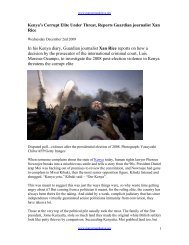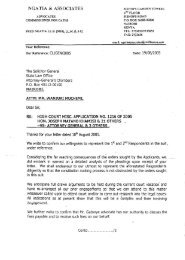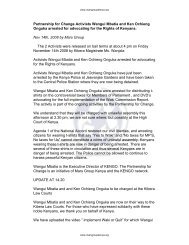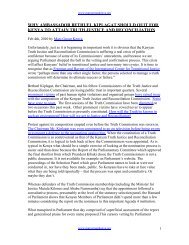Navy story.indd - Mars Group Kenya Publications
Navy story.indd - Mars Group Kenya Publications
Navy story.indd - Mars Group Kenya Publications
Create successful ePaper yourself
Turn your PDF publications into a flip-book with our unique Google optimized e-Paper software.
economy<br />
east africa<br />
No Eassy rider<br />
<strong>Kenya</strong> and South Africa are<br />
in heated dispute over the<br />
control and cost of a crucial African<br />
development project – a fibre-optic<br />
cable to surround the continent and<br />
link it to the world by 2008.<br />
One of its main components,<br />
the East African Submarine System<br />
(EASSy), would place 9,900<br />
kilometres of fibre beneath the sea,<br />
between Port Sudan in the north and<br />
Mtunzini in South Africa; it would<br />
link up with the SAT3 cable which<br />
starts in Portugal and connects West,<br />
Central and Southern Africa with<br />
Madagascar, India and Malaysia.<br />
The EASSy row embarrasses South<br />
Africa, which is promoting the<br />
project within the New Partnership<br />
for Africa’s Economic Development<br />
(NePAD), whose secretariat it hosts.<br />
Other member states and investors<br />
are frustrated by the resulting delay.<br />
EASSy would reduce the price of access<br />
to international broadband by 65 per<br />
cent. The average price in Africa for 1<br />
gigabyte per second (gbps) of data per<br />
month is US$1,800, 90 times the price<br />
in the United States.<br />
‘The cost of routing traffic<br />
internationally costs the continent<br />
$400 million annually,<br />
representing major capital flight<br />
out of Africa’, says Eric Osiakwan,<br />
Executive Secretary of the African<br />
Internet Service Providers (ISPs)<br />
Association. The main sticking<br />
points are ‘open access’ and the<br />
regulatory role of a government<br />
structure that would own the<br />
network. A protocol defining these<br />
matters was agreed upon in Kigali<br />
on 29 August, but of the 23 states<br />
involved only Tanzania, Uganda,<br />
Rwanda, Lesotho, Malawi,<br />
Madagascar and South Africa<br />
attended the signing.<br />
Both the African Development<br />
Bank and the World Bank want<br />
the EASSy project to use the ‘open<br />
access’ model which means that<br />
service providers could get access<br />
to the cable at cost – and sell its<br />
services on to customers in the region.<br />
The big foreign telecom companies<br />
and their state counterparts in Africa<br />
object because they would have to<br />
surrender a substantial chunk of their<br />
profitable business to much smaller<br />
companies and civic organisations.<br />
On 18 September, 31 telecom<br />
companies threatened to pull out of<br />
the project, saying the Kigali protocol<br />
was unworkable and would ‘delay the<br />
implementation of the EASSy cable<br />
to the extent of it being abandoned’.<br />
The <strong>Kenya</strong>n government had already<br />
said it might quit the project in favour<br />
of its own proposed undersea cable<br />
link The East African Marine Systems<br />
(TEAMS) between Mombasa and<br />
Fujairah, United Arab Emirates.<br />
The Permanent Secretary of<br />
<strong>Kenya</strong>’s Ministry of Communications,<br />
Bitange Ndemo, said <strong>Kenya</strong> would<br />
not sign the protocol unless the<br />
regulation issue is resolved. TEAMS<br />
could be cheaper and faster than the<br />
EASSy cable and start up next year.<br />
Moreover, says Ndemo, ‘NePAD is<br />
controlled via South Africa…first we<br />
want the EASSy project to be out of<br />
any governmental control and later<br />
on we can talk about the open access<br />
model.’<br />
The head of NePAD’s East Africa<br />
commission, Dr. Henry Chasia, is<br />
<strong>Kenya</strong>n but questions his government’s<br />
position: ‘It would be regrettable if<br />
<strong>Kenya</strong> opted to go it alone and built<br />
its own under-sea fibre optic cable<br />
as this would weaken the EASSy<br />
initiative’. Telkom SA, South Africa’s<br />
main telecom company and one of the<br />
project’s main backers, has also said<br />
it may pull out because it might not<br />
be able to make enough return on its<br />
$10mn. investment. The government<br />
in Pretoria, keen to avoid losing face<br />
and needing plenty of bandwidth for<br />
the 2010 World Cup, may have other<br />
ideas. Industry sources say Telkom<br />
may simply be trying to strong-arm<br />
the government.<br />
Others say the project’s flaws<br />
include a lack of competition in who<br />
can bid, the unclear extent to which the<br />
project is controlled by governments<br />
and layers of bureaucracy where<br />
‘friends’ of member governments<br />
might be placed. Another signing<br />
ceremony is scheduled for 16<br />
November in South Africa, but <strong>Kenya</strong><br />
will not attend unless its concerns<br />
about over-regulation and Pretoria’s<br />
monopolisation of the process are<br />
addressed.<br />
Its own undersea link would be an<br />
insurance policy. Uganda will host<br />
next year’s Commonwealth Heads<br />
of Government Meeting; its private<br />
telecom companies might jump ship<br />
and join <strong>Kenya</strong> if TEAMS, built by<br />
<strong>Kenya</strong> Data Networks, subcontracted<br />
to Flag Telecom, arrives first with its<br />
promised very low tariffs, at $150<br />
per megabyte per second (mbps) per<br />
month. EASSy’s backers are confident<br />
that their scheme will be realised by<br />
the end of 2008. But are the investors<br />
still interested and will they remain<br />
so when TEAMS comes on stream l<br />
1 0 2 0 O c t o b e r 2 0 0 6 - V o l 4 7 - N ° 2 1 - A f r i c a C o n f i d e n t i a l







